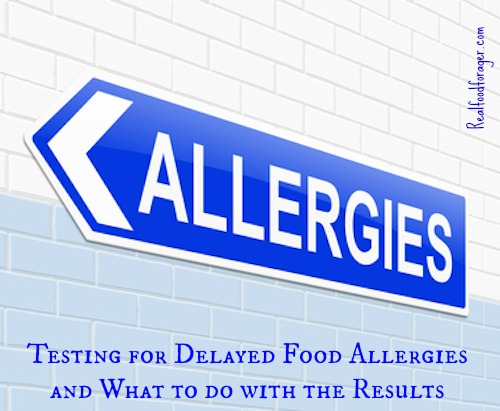
There is a lot of confusion among clinicians and patients about all the different types of allergy testing available and which tests are appropriate. I just finished listening to a former nutrition teacher of mine who is a brilliant researcher and expert on allergy testing. Unfortunately many types of delayed allergy testing results in numerous foods that a person is sensitive to – usually everything the person is eating. This makes one wonder if that type of testing is accurate.
The immune system is very complex and there is so much we do not understand about it. But there is a lot we do know about that I will discuss briefly so that you can understand how the delayed allergy testing is done.
The immune system has two parts: the innate and the adaptive systems. We know that the immune system is there to defend us against foreign intruders. But it is also supposed to interact in the repair of cells. However, when it is preoccupied with defense, it cannot satisfactorily serve its repair function and health problems develop.
Innate System
The innate system is the first line of defense. It automatically deals with everything we come into contact with before it can enter the body. This system provides immediate defense to any threat, starting from the first encounter. It includes the skin, upper respiratory tract and the gastrointestinal tract.
This system is self regulating (homeostatic) and when it is strong we are tolerant, strong and can recycle anything that is foreign and repair anything that needs mending and can even eliminate cancer cells.
However, many people have lost that tolerance because they are not getting enough of the good nutrition they need and they are calling on their reserves which leads to a reliance on the adaptive immune system.
Adaptive Immune System
The adaptive immune system (cellular immune system) consists of B and T cells. You may be taking in partially digested foods or chemicals with every meal, through a leaky intestinal wall. This burdens the adaptive immune system, which responds to the cellular triggers with antibodies (B cells) and T cells.
This response creates all the common chronic health problems we see today such as asthma, arthritis, eczema and all the autoimmune chronic inflammatory conditions.
The immune system is made to defend and repair, but under the constant burden of having to be in the defense mode due to lifestyle and diet, the repair function is postponed which leaves the body vulnerable to inflammation and the health sequella.
Food Allergy Testing
There are many opinions about food allergy testing. Some doctors argue that it is inaccurate. Even some medical doctors do not believe in IgE immediate allergy testing.
Other medical doctors have entire practices based on conventional IgE allergy testing and some of these doctors do not believe in the 3 other pathways of immune testing.
The immune system is so important is has a total of 4 pathways to combat foreign invasions and help repair the body.
Delayed testing involves the additional 3 more pathways (the first being: Type I, IgE immediate allergies). The Type II pathway involves IgG, IgM and IgA which are B cell, antibody related.
The Type III response is the Immune Complex Trigger (IgM complex).
The Type IV response involves T cells (no antibodies) which respond directly to the stimulus.
The human immune system is elegant and extremely complex and is being studied all the time. Identifying delayed triggers is very difficult and there had been a lot of different approaches to this type of testing.
Tests of Delayed Hypersensitivity
There are 3 test methods:
- Antibody test
- Particle size tests
- lymphocyte response tests
Delayed reactions can take 2 hours to 2 weeks to develop symptoms and it is much harder to identify problematic items. Symptoms may not even be noticeable but still be a burden on the immune system.
The Lymphocyte Response Assay (by ELISA/ACT method) is a test that will measure all the delayed pathways and pick up only the harmful (not the helpful) complexes.
This test is directly observing lymphocytes under conditions similar to the body when it is exposed to a trigger. It is also ex-vivo which means that they look at it in a functional way, as if it were in the patient’s body. It covers all 3 of the delayed pathways and yields very low false positives.
What to Do with the Results
The result will show food and chemicals that you react to and will give recommendations.
The first important action is to stop the attack on the immune system by eliminating the foods and chemicals that activate your individual immune responses.
Elimination of these offending foods and chemicals needs to last at least 6 months.
Many labs also offer a program to rebuild the body by targeted supplementation, lifestyle changes and appropriate diet. This will focus on rebuilding the microbiome and metabolism.
Most labs use IGg testing — this is not functional but static — an antibody may be helpful (or harmful) but you cannot tell from this test. These tests measure the physical quantity of the antibodies but cannot distinguish between those that are provocative and those that are helpful antibodies.
Even with IgE testing (immediate allergies) — there can be high IgE antibodies but no apparent problems (which I have seen many times in my patients) because the IgG4 pathway balances out the IgE. In fact, this is the goal of standard conventional immunotherapy – to use IgG4 to balance out the high levels of IgE.
IgG, IgG4, IgA IgM Testing
The problem I have found with the various labs I have used for IgG testing, is that they measure the presence and amount of specific antibodies – but they do not distinguish between the antibodies that are causing symptoms and those that are protective.
Patients typically receive a long list of items to avoid which makes their diet very difficult to remember and follow – almost impossible.
Additionally, they may very well be avoiding foods that are not problematic to them at all – foods that may very well be helpful to their healing.
In fact, 3/4 of IgG antibodies are helpful rather than harmful – they help to neutralize things and only 1/4 are harmful and you can’t tell this from a standard IgG test. You may have a lot of protective antibodies over the years.
The T cell responses (T1/T2) are not measured in IgG testing. Standardizing a cell culture as in the Lymphocyte Response Assay, appears to be much more accurate. With this test the outcome studies are very positive and less than 3% variance day to day in accuracy between studies on the same blood sample.
Leaky Gut
The microbiome and the metabolism communicate to keep things homeostatic. There may be a repair deficit that results from various things like infection, antibiotics, toxic metals, stress, environmental pollutants, hormones, allergens, etc.
If the digestion is impaired, (very common) it interacts with the repair deficit and results in leaky gut. This results in chemicals and particles getting into the blood stream that should not.
You need enough of the good stuff coming through that you can digest, assimilate and eliminate without burdening the immune system. Normally there should be enough protective mechanisms such as mucin, Secretory IgA, proper methylation, etc. You need good microbes (40 billion a day or more), natural vitamins, real food, good natural fiber, (40mg/day).
Eat real foods – biodynamic, organic, vine ripened, local grown when possible. Invest in your kitchen as an investment in your health.
The immune system can be reset to be tolerate foods coming in and to be more involved with repair than to be burdened with defense. Identifying what the invaders are in a comprehensive way may be very helpful for those who are still having problems in spite of a good real food diet.
Intervention should also include anti-oxidants, vital nutrients such as buffering minerals, essential co-factors in order to bring the body back into homeostatic equilibrium.
After this rehabilitation, a person should be able to eat some of the original offending foods. The microbiome will be able to interact with the metabolism in a healthy way.
Time Frame
It can take about one month for every year of illness to recover. For some, it can take only 6 to 8 weeks to start to feel better – or at least to have more good days than bad days.
You can retest at 6 months, (this is based on the life cycle of the lymphocytes). If someone is totally well you can start to carefully reintroduce some of the foods.
Many people following a good real food diet like that of the Weston Price Foundation may still have problems. Even those that have gone through the SCD, GAPS or Paleo diet may still have symptoms. For some, this type of allergy testing can make a huge difference.
This article is based on a talk given by Dr. Russell Jaffe, a nutrition teacher of mine who just spoke at the Functional Health Summit. I have been learning so much from the expert speakers at this summit this week!
Click here to find our more about the Functional Health Summit
To find out more about Dr. Russell Jaffe and his work:
- www.elisaact.com – technical info
- Healthstudiescollegium.org – more technical info
- Betterlabtestsnow.com – for consumers about lab tests
Shared at: Fight Back Friday, Hearth & Soul Hop, Real Food Wednesday, Allergy Free Wednesday
The owner of this website is a participant in the Amazon Services LLC Associates Program, an affiliate advertising program designed to provide a means for sites to earn advertising fees by advertising and linking to Amazon properties including, but not limited to, amazon.com, endless.com, myhabit.com, smallparts.com, or amazonwireless.com. Disclaimer
Tropical Traditions Gold Label Virgin Coconut Oil

Tropical Traditions Gold Label Coconut Oil is a product I use every day.










{ 3 comments… read them below or add one }
However, the optimism still reveals, that the company might soon see a breakthrough in some of its product or services that may bring back all the lost charm and
falling numbers for them sooner. The latest statistics
show that at least over 900 new viruses are created each month which makes keeping track of
them really quite difficult. To guard your system facing all these harmful progra ms everyone needs common YOUR COMPUTER preventive.
Great article! We are linking to this great post on our
site. Keep up the good writing.
I have been following a real food diet for two years now. Unfortunately, my colon was removed entirely in 1998. This past year I have been supplementing my diet with fermented cod liver oil and a probiotic pill, in addition to eating home-fermented foods. I many have caused SIBO with the probiotic, since I have no colon. I have been experiencing discomfort and gas recently and stopped taking the probiotic pill but am still eating small amounts of ferments regularly. I am realizing I need professional help with all this, but don’t know where to turn. I read voraciously on the subject, but have not seen anything about anyone without a colon. Also, I was diagnosed with Primary Immune Deficiency Disease 2 years ago and put on weekly subcutaneous infusions of IgG. After reading this article, I’m thinking “Now what?”
Any light you can she’d or help you can point me to will be appreciated. Thank you.
{ 1 trackback }